Overcoming Challenges
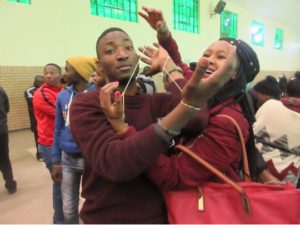
This year’s workshop particpants brought an abundance of good humor and trust to every task, no matter how difficult – or how silly. Here, we begin our first day in Bloemfontein with an icebreaker activity that’s designed to emphasize the importance of creative problem solving skills. We asked pairs of teachers to don interlocking “handcuffs” made out of rubber bands and string. Each duo had to puzzle through how to disentangle themselves without taking off the handcuffs. Though it was early in the morning, freezing cold, and the teachers had only just met each other, they dove right into the dillema, wiggling around to extricate themselves, laughing as they squirmed and twisted. The activity was a much bigger hit than I expected and perfectly set the tone for the sort of active and creative tasks we’d be engaging in during our experiments. The South African teachers’ jobs are rife with challenges, many of which are out of their control, and despite this they showed up during their vacation, ready to work hard. They brought a willingness to try a strategy, fail, reconsider the problem and try again that ultimately enabled us to have a productive, fun and enriching experience at the workshop.
Improvisation and Teamwork
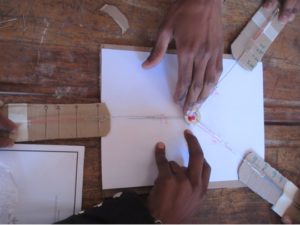
I was pleasantly surprised at how effectively our homemade spring scales worked for our vector addition activity. The South African teachers took genuine pride in creating their own scientific equipment out of simple materials. After building them, they calibrated the scales using known masses of water. Since each scale used a different rubber band, each had to be calibrated separately. This led to a nice mix of collaboration and individual work amongst the groups working at each table; since each scale was unique, the teachers couldn’t copy from each other so they each had to really think through the task, asking each other questions as they worked. The cooperation necessary to draw and measure the vectors also generated productive dialogue about the purpose of each step. At each table, one teacher would take the lead in directing their colleagues on how each person should use their scale so that the whole group could create a set of balanced vectors. Even though most of the teachers were already aware of the vector addition theory, they were uniformly astonished when they experimentally proved these principles in such a straightforward manner. It was great fun to see their surprise and delight at being able to derive these rules for themselves.
Inspiration All Around
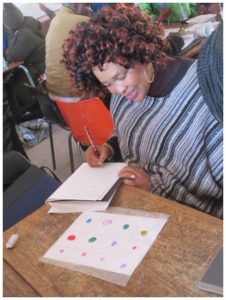
In every workshop this year, we extracted the pigment from a purple cabbage and used this solution as an indicator to determine whether common household substances are acidic, neutral, or basic. Despite the simplicity of this technique and it being suggested in the South African CAPS curriculum, none of the teachers had ever done this. They were fascinated to test everyday substances and see the indicator’s color change. While I was impressed that they manage to teach acid-base chemistry from a completely theoretical perspective, they were impressed by the variety of experiments we could perform with grocery store products. One teacher said, “I knew vinegar was acidic but I didn’t realize it is so useful for teaching!” Each teacher went home with a sample of the purple cabbage juice to use with their classes. Even so, the reality is likely that while some of these teachers may alter their pedagogy to be more experiential and discovery-driven, many others will not. They still struggle to manage their large class sizes, busy teaching loads, and other challenges beyond their control. Still, I hope that our week of doing experiments with common materials shifts their thinking about what constitutes scientific equipment and what fundamental scientific principles can be easily demonstrated with everyday objects.
Original Ideas
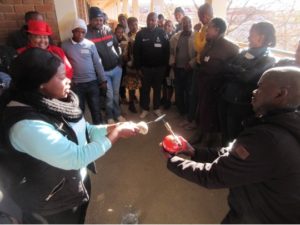
One of my favorite aspects of TABSA is how the South African teachers take control of the workshop and really make it their own. Invariably, this is when I learn the most. A few days into the week, when everyone starts to get more comfortable, teachers will begin sharing new ideas and things start to get exciting. When a lively debate broke out in Bloemfontein about whether copper sulfate is blue because it contains copper or because of the water associated with it, Thomas (holding the torch) suggested that we use thermal energy to drive the water out of a sample of copper sulfate and then check the color of the anhydrous form. This is a common experiment that is often performed quantitatively but here it was a useful way to make a qualitative color observation and reinforce the difference between a chemical change and a physical change. The teachers were so impressed with the color change from blue to white that they insisted upon an encore – rehydrating the sample, rendering it blue again, and repeating the drying experiment. Thomas was delighted with the success of his idea and seeing the color change a second time seemed to impress the group even more than it did the first time!
Improving the Curriculum
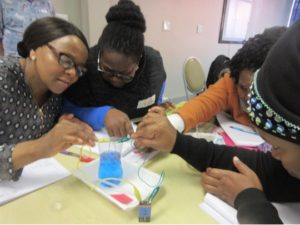
During our East London workshops, middle school teacher Siziwe Makuleni brought in her eighth grade science textbook to show me a recommended experiment. She didn’t have the necessary materials to try it herself but she asked if we could figure out how to do it. The text described how to conduct an electrolysis experiment with copper chloride in order to demonstrate a decomposition reaction. The directions noted that the products of the reaction would include toxic chlorine gas, so great care must be taken to work in a well-ventilated space. Since obtaining copper chloride is difficult and expensive in South Africa we decided to substitute a different copper salt, copper sulfate. This was a major improvement, as copper sulfate is cheap and ubiquitously available in pharmacies. In addition, nontoxic oxygen gas is produced instead of harmful chlorine gas. The original goal of the reaction, decomposing a copper salt reactant into a metal product and a gaseous product, is still achieved in our version of the experiment. The South African teachers were thrilled with our amended experiment’s easily accessible materials and harmless products. Siziwe and many other teachers were indignant that this safe version of the experiment was not the one in their book and there was much discussion amongst the group about how to take action to amend the text. Seeing their investment in this issue makes me hopeful that the South African teachers are developing a greater sense of ownership over their curriculum.
Eradicating Misconceptions
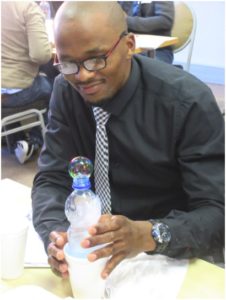
As part of our middle school activities to demonstrate the particle nature of matter, we experimented with heating and cooling air to observe a soap bubble expand and contract. My intent was to link this simple observation to the kinetic energy of the air particles; warm air particles move faster than cool air particles and push on all sides of the container with more force, making the bubble expand. However, I was surprised when many teachers quickly explained the bubble increasing in size as a result of the warmer air moving up to the top of the bottle. They were very adamant that hot air rises and were using this knowledge as rationalization for why the bubble expanded up when the air in the bottle was warmer but contracted down when the air in the bottle was cooler. Despite this being an incorrect explanation, I had to admit that the evidence provided by my activity could be misinterpreted in that manner. Having the group leave with the wrong impression from this activity was not the outcome I wanted, so I hastily tried to figure out how to provide evidence to refute that explanation. While I fumbled for an idea, one of the South African teachers stood up and delivered an elegant solution; he turned the bottle on its side and demonstrated that the warmer air causes the soap bubble to bulge out sideways, indicating that the air is expanding in all directions, not just moving up. I was amazed by how simple and obvious this was and grateful for both his ingenious thinking and his willingness to push back on his colleagues’ explanation. Of course, in retrospect this seems basic to me but in the moment it was a revelation. Once the rest of the South African teachers saw his demonstration and listened to his rationale of why his description made sense, they set aside their misconception and accepted his explanation of how and why warm air expands. This experience taught me a valuable lesson about how considering a problem from multiple directions – literally- can help one discover a solution.
